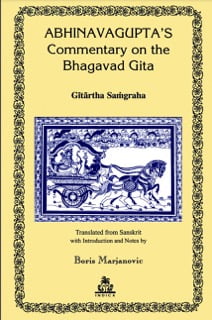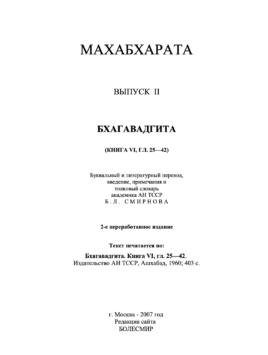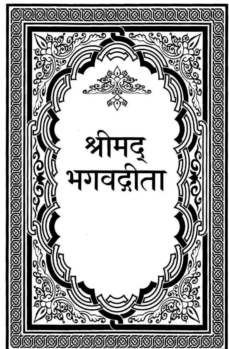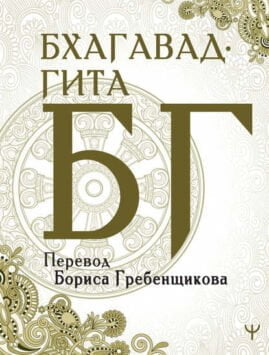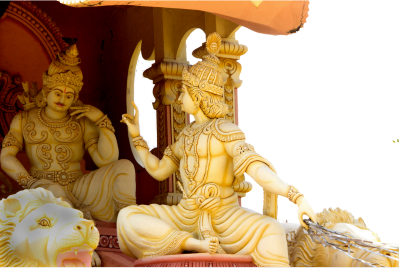
Bhagavad Gita
One of the main texts of Indian culture is the Mahabharata, in which a separate chapter is devoted to the description of the existential crisis of the main character Arjuna.
This chapter is called The Bhagavad Gita.
According to the plot, Krishna gives advice to Arjuna on how to get out of the confusion that has engulfed him. Krishna’s words are a description of various meditations that can be useful for modern practice as well.
The Yoga of the Bhagavad Gita
Andrey Safronov
The Bhagavad Gita translation by the project “Sanskrit in Ukraine” is in progress
The commentary tradition and Abhinavagupta’s commentary on the Bhagavad Gita
Imagine that you are listening to or preparing a lecture. Normally, you would write down the main points in a notebook or presentation. And to you, this outline makes sense. Looking at each thesis, you would remember what was discussed and what arguments preceded each thesis. But if someone who has not heard the lecture reads your notes without knowing the whole context, the arguments, they will be left to guess what your brief theses are about.
This is the situation in which the interpreter finds himself when reading sutras, tantras or karikas. In order to understand the written, he has to find the context from which the writings were made. His task is to see the whole story in detail behind the brief phrases. Such unfolding of the full context through an extensive explanation is what we call a Commentary.
Yoga texts choose to cover subtle things: the structure of the human inner world, thought processes, psychic reactions, practices of mind control and development. Without commentary, a description of all this is like a physical formula without explanation or proof. Even if the commentator gives an explanation that is not all 100 percent equal to the ideas of the author of the text, it will be a significant support for understanding the whole context. For the sake of this, we read commentaries on the condensed statements of primary yoga sources.
This post focuses on Abginavagupta’s commentary on the first line of the Bhagavadgita.
It gives us a context for understanding the Gita that would not come to mind when reading the translation or the original.
Namely, the commentator points out that the field of Kuru, where the main characters meet, is the inner world of man (this is logical enough, based on the metaphor of the chariot given in the following chapters). And the word “Kuru” itself has the meaning of “act!” The Kauravas and the Pandavas from Abginavagupta’s point of view are opposite sensations that fight for the right to generate action – passion and impartiality, anger and peace.
The Bhagavad Gita in the original, with 8 commentaries
At the link below is the Sanskrit text of the Bhagavad Gita with several classical commentaries, also in Sanskrit (by Ramanuja, Abhinavagupta, Shankara, etc.).
Source
The Bhagavad Gita in the original, with the commentary of Abhinavagupta
The original text of the Bhagavad Gita with the Gitarthasangraha commentary by Abhinavagupta in English translation.
Text
Bhagavadgita in the original, audio version
Many people are curious about how the Bhagavad Gita sounds in the original. The video below is a non-classical but very good rendition of some lines of the Gita.
https://www.youtube.com/watch?v=8yNE3-H8Xtg&ab_channel=VrindavaniDevi
Part one
Part two
Translations of the Bhagavad Gita
Abhinavagupta’s Commentary on the Bhagavad Gita. Gitartha-sangraha
translated by Boris Maryanovych
in English
Bhagavat Gita
Translated by Boris Smirnov
This translation, while remaining literary, is quite close to the original text.
It is also convenient that it does not contain any commentaries.
Bhagavat Gita
translated by Dmytro Burba
This is a grammatical translation. In the sense that it will be of primary interest to those who want to familiarize themselves with the grammatical details of the original, since a detailed parsing of the parts of speech is provided for each line.
The BG Bhagavat Gita
translated by Boris Grebenshchikov
This work should not be called a “translation” because it was not created from the original, but was the result of comparing several translations into Russian.
Here is what BG himself writes about this translation:
“My task as an interpreter was to translate the content of what was said in the Gita into the simplest Russian language. I tried to get rid of the usual – arrogant and vain – poetic style, because, in my opinion, God, who speaks here in the person of Krishna, cannot speak in an unnatural language. The language of God is infinitely more natural than the speech of men, because He is – Essense and Simplicity. So I decided: the simpler and clearer the translation, the better.
This is what I was starting from.
And to achieve the result of my search, first I translated into Russian the familiar text of Christopher Isherwood, then for several years I compared my translation of each verse with the translations of A. A. Petrov (1788), A. A. Kamenskaya and V. de Manziarli, B. L. Smirnov, V. G. Erman, V. S. Sementsov, Swami Prabhupada and S. M. Neapolitansky and searched for words that would convey the essence of what was said as clearly and directly as possible.
Whether I succeeded is for you to judge.”

